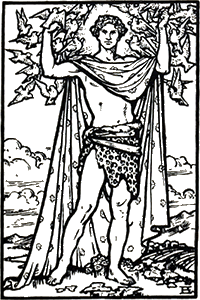Dublin or Baile Átha Cliath? Blackpool or the or the Ford of Hurdles? On the name origins of Ireland's capital city.
Ireland's capital city gives us an interesting example of an Irish place name where the commonly used English form and the native Irish form bear no relationship to each other.

Unlike many Irish place names, Dublin is not transliterated from or related to the Gaelic name for the area: Baile Átha Cliath and each name describes different things.
In fact, if the original Irish form was correctly transliterated, Ireland's capital would be called something like Ballyaclee.
As a settlement Dublin is said to have been first occupied by Viking traders c.988AD. Sailing their longships up the River Liffey (originally called An Ruirthech or the 'stampeding-one') they came upon a dark tidal-pool at the site where the River Poddle and the River Liffey met and which they appropriately named Dyflin, meaning ‘black-pool’, which later took the Irish form Dubh Linn.
Meanwhile, the native Irish referred to this place as Baile Átha Cliath, meaning the ‘Town of the Ford of Hurdles’.
This actually described an important river crossing (not too far from the current site of Father Matthew’s Bridge) where four roadways (slighe or slí) met at a point on the Liffey allowing for low-tide crossing by way of a series of hurdles of interwoven saplings.

So why is it known as Dublin and not Ballyaclee today?
From the 12th century Dublin was controlled by the Anglo-Normans who, despising anything overtly Gaelic, chose to retain the Viking version of its name, albeit in an anglicised form, and it became the more dominant name over time.
It was during this time that the area would come to be known as An Pháil Shasanach - the English Pale.

The Pale was an area stretching as far north as Drogheda, County Louth, and as far south as Dalkey, County Dublin, including parts of Counties Meath and Kildare within its boundary. The word pale derives from the latin pālus meaning a ‘stake’ or a ‘pole’ but more specifically a ‘fence’ or ‘boundary restriction’.
It represented the division between the Irish and English cultures and legal systems and gave rise the the phrase ‘beyond the pale’; a term created by the English to mean ‘unacceptable’ or ‘uncivilized behaviour’ in reference to the customs of the native Irish people.
Dublin remained a centre of British rule in Ireland until the creation of the Free State in 1921 when it became the new seat of Dáil Éireann, the Irish Parliament.
On a separate note, problems with smog persisted until the 1980’s, earning Dublin its still commonly used nickname ‘the Big Shmoke’.
--------------------------
If you liked this content and would like to learn a lot more about early Irish history and society, check out my online course: Ancient Ireland's Culture and Society and Save 20% through this site.
Feel free to reach out to me at: [email protected].














